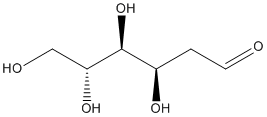All AbMole products are for research use only, cannot be used for human consumption.

2-Deoxy-D-Glucose (2-DG) is a glucose analog that inhibits glycolysis via its actions on hexokinase, the rate limiting step of glycolysis. It is phosphorylated by hexokinase to 2-DG-P which cannot be further metabolized by phosphoglucose isomerase. Most tumor cells showed higher DG uptake and 3-O-MG transport than the human fibroblast cells. The 2DG6P content in isolated rat soleus muscle after incubation with 2-deoxyglucose (2DG) was increased in a dose-dependent manner by insulin (ED(50) = 0.6 mU/ml), the maximum response being about 5 times that of the basal content in vitro. 2-DG increased mitochondrial dysfunction and upregulated Bax/Bcl-2, promoting cytochrome c release to initiate procaspase 3 cleavage induced by buforin IIb.
2-DG plus BCNU significantly suppressed tumor growth with lower side effects compared with BCNU alone in tumor-bearing mice. 2-DG also exerts anticonvulsant effects in vivo against perforant path kindling in rats. Rats fed the 2-DG diet exhibited significant reductions in resting BP, attenuated BP responses during stress, and accelerated recovery to baseline after stress. Plasma concentrations of ACTH and corticosterone were elevated under nonstress conditions in rats fed the 2-DG diet and exhibited differential responses to single (enhanced response) and multiple (reduced response) stress sessions compared with rats fed control rat chow ad libitum. The 2-DG diet improved glucose metabolism, as indicated by decreased concentrations of blood glucose and insulin under nonstress conditions, but glucose and insulin responses to stress were maintained.

J Transl Med. 2024 Aug 12;22(1):754.
Paired organoids from primary gastric cancer and lymphatic metastasis are useful for personalized medicine
2-Deoxy-D-glucose purchased from AbMole

Transl Cancer Res. 2023 Oct 31;12(10):2823-2836.
Ubenimex suppresses glycolysis mediated by CD13/Hedgehog signaling to enhance the effect of cisplatin in liver cancer
2-Deoxy-D-glucose purchased from AbMole

Front Immunol. 2021 Feb 25;12:620365.
Circulating Neutrophil Dysfunction in HBV-Related Acute-on-Chronic Liver Failure
2-Deoxy-D-glucose purchased from AbMole

Redox Biol. 2020 Oct;37:101761.
Stat2-Drp1 mediated mitochondrial mass increase is necessary for pro-inflammatory differentiation of macrophages
2-Deoxy-D-glucose purchased from AbMole

Cell Death Dis. 2020 Oct 23;11(10):902.
The miR-30a-5p/CLCF1 axis regulates sorafenib resistance and aerobic glycolysis in hepatocellular carcinoma
2-Deoxy-D-glucose purchased from AbMole
| Molecular Weight | 164.16 |
| Formula | C6H12O5 |
| CAS Number | 154-17-6 |
| Solubility (25°C) | Water 30 mg/mL DMSO 15 mg/mL |
| Storage |
Powder -20°C 3 years ; 4°C 2 years In solvent -80°C 6 months ; -20°C 1 month |
| Related Cell Culture Products |
|---|
| Yeast Nitrogen Base (Without Amino Acids and Ammonium Sulfate)
Yeast Nitrogen Base Without Amino Acids and Ammonium Sulfate is recommended to use for classifying yeasts based on their carbon and nitrogen requirements. The medium contains all essential nutrients required for the growth of yeasts except amino acids, histidine, methionine and tryptophan, and also ammonium sulphate. The addition of nitrogen and carbon sources is required. |
| Poly-L-lysine (MW 70000~150000)
Poly-L-lysine is a positively charged amino acid polymer that can bind to DNA, red blood cell membranes, or any negatively charged protein. It is a non-specific cell adhesion factor that promotes cell adhesion to solid substrates. |
| MEISi-1
MEISi-1 is a homeodomain inhibitor of small molecule MEIS1 protein. MEISi-1 induced self-renewal of mouse and human HSCS in vitro and in vivo. MEISi-1 can be used for research in blood diseases, heart regeneration and cancer. |
| TCS 2210
TCS 2210 is a neuronal differentiation inducer in mesenchymal stem cells (MSCs). |
| (-)-Variabilin
(-)-Variabilin promotes differentiation of neural stem cells into neurons. (-)-Variabilin is an Neurogenin2 (Ngn2) promoter activator isolated from Butea superba. |
All AbMole products are for research use only, cannot be used for human consumption or veterinary use. We do not provide products or services to individuals. Please comply with the intended use and do not use AbMole products for any other purpose.


Products are for research use only. Not for human use. We do not sell to patients.
© Copyright 2010-2024 AbMole BioScience. All Rights Reserved.
